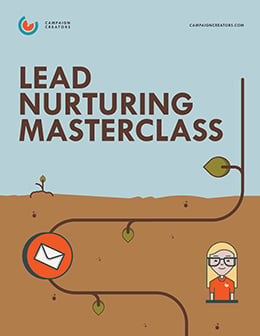Welcome back to the Lead Nurturing Masterclass! Last lesson you learned how to generally craft a lead nurturing campaign. In this lesson, you’ll learn to create a lead nurturing campaign specifically for the realm of selling business-to-business (B2B), where you are typically dealing with longer sales cycles, multiple decision makers, and more complicated products.
The B2B Customer Lifecycle
Customer lifecycle is a term used to describe the progression of steps a customer goes through when considering, purchasing, using, and maintaining loyalty to a product or service. While there’s no single way to define a customer lifecycle for a B2B business, the following basic lifecycle is a good starting point for most:
- Visitors/Subscribers
- Marketing Lead
- Marketing Qualified Lead
- Sales Qualified lead
- Opportunity
- Customer
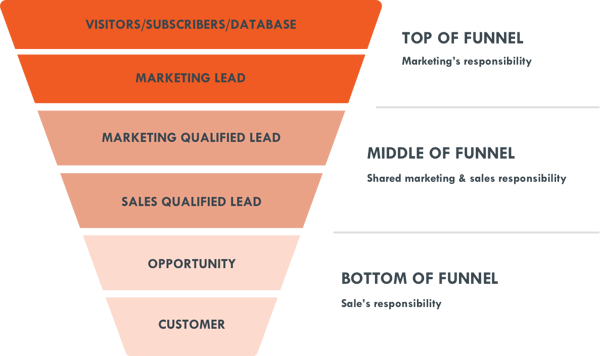
Now as you can see, your job as a marketer is to turn Visitors into Sales Qualified leads to pass off to your sales team to close into customers.
And how can you do that?
Well, according to DGR’s B2B Buyer’s Survey,
“88% of buyers said that the winning vendor they chose provided a better mix of content to help them through each stage of the research and decision-making processes.”
But industry experts point out that connecting the dots—and the content—in ways that mirror the customer journey, is crucial. And that’s exactly what your lead nurturing campaign will do!
So, let’s get into how you can guide, educate, and delight your B2B buyers.
Core Elements of a B2B Lead Nurturing Campaign
As covered in Lesson 6: Lead Nurturing Campaigns, the core pieces for a building a lead nurturing campaign include:
- Lead Magnets
- Landing Pages
- Personalization and Segmentation
- Emails
- Workflows
- Nurture Content
- Reporting and Analytics
- Optimization
- Operator
- Automation Tools
Hook (aka Lead Magnet)
The reality is that most B2B buyers are not going to be ready to make a purchase the first time they come into contact with your brand or land on your website. So the main goal of your hook or lead magnet is to attract a visitor to your website and convert them into a lead in your database. That way you can learn more about them and further your relationship, even though they are unready to purchase at that time.
With this in mind, your lead magnet should focus on engaging unaware prospects and website visitors. Remember this audience hasn’t provided you much information other than how they interact with your company in a minimal manner, such as coincidentally viewing one or more similarly focused blog posts on your website.
To create an attractive and valuable B2B lead magnet, you must help your buyer identify a challenge they have, an opportunity they want to pursue, or provide an answer to one of their questions.
Landing Pages
Landing pages are a primary means of hosting your lead magnet, as well as presenting premium content at later stages of your funnel. Revolving around presenting your lead with the opportunity to provide their information in exchange for a promising offer, landing pages should be focused on conversion. While design does matter, the creative effort put into your page will be for nothing if it doesn’t compel leads to submit the form!
Elements that prove effective in converting a B2B audience on landing pages include all that was stated in Lesson 6, as well as:
- Trust building elements such as testimonials and trust logos
- Bullet points outlining the key benefits of your offer
- A highlight as to who would benefit from your offer (i.e., ideal for those responsible for marketing operations at their company)
Annual benchmarks for B2B landing pages include:
- Average Views-To-Submission Rate: 20%
- Exit Rate: Under 50%
- Bounce Rate: Under 60%
- Average Time on Page: 2 minutes
Personalization and Segmentation
What’s unique about a B2B targeted audience? In B2B, more so than B2C, a more personal relationship needs to be forged between the individual marketer and the buyer. Therefore, personalization should also be utilized on the sender’s side, meaning content and offers should be sent from a specific person within the marketing team or company rather than from the brand.
But, personalization for B2B audiences is not just about adding a first name token to your email greeting—it is all about providing your lead with the content they need, when they need it. How do you do this with your lead nurturing campaign? By segmenting leads according to their needs, understood by touchpoints they made along converting from one stage of the buyer’s journey to the next.
Segmenting B2B leads should take into account:
- A lead’s stage in the buyer’s journey
- The lead’s persona
- The lead’s entry point into your marketing process
- Content a lead has interacted with
Further segmentation can be executed on by looking at a lead’s “firmographics,” such as company criteria like:
- Size
- Industry
- Location
- Technologies
With this information in hand, you can properly assess your leads’ needs and respond with the best-fit actions or content. Offering this more personalized experience will often set you apart from competitors who are running on a one-size fits all approach.
Emails
B2B audiences tend to have longer buyer’s journeys than B2C audiences. Why? Because, often, they require greater awareness about the problem they face, needing more education in how to solve for it, as well as why your company will provide them the best solution for them.
Email drips help solve for this by taking a hands-off, nurturing approach. Emails drips are a series of scheduled emails, used to encourage a lead to access the next content piece in your funnel or take a desired action.
They offer a personalized approach even when a one-on-one conversation can’t be met.
When delivering emails to B2B audiences, you should take note of the kinds of emails that perform best at each stage of their buyer’s journey. You should also seriously evaluate the purpose for sending the email. If you can’t answer yes to the following questions, you probably shouldn’t be sending it:
- Does this email help build a relationship between the lead and your brand?
- Does this email help the lead progress further in their journey?
- Does this email provide value to the lead?
Workflows
Workflows in lead nurturing campaigns primarily function to guide a lead from one stage of your funnel to the next. This is incredibly important for re-engaging lost leads, those who do not convert immediately. These workflows, triggered whenever a lead fills out a form to claim one of your offers, automate the sending of a series of messages, in B2B these are typically emails. The emails serve to introduce and promote the next offer in your funnel. So, the goal of your workflow is for a lead to fill out the form to claim your next offer.
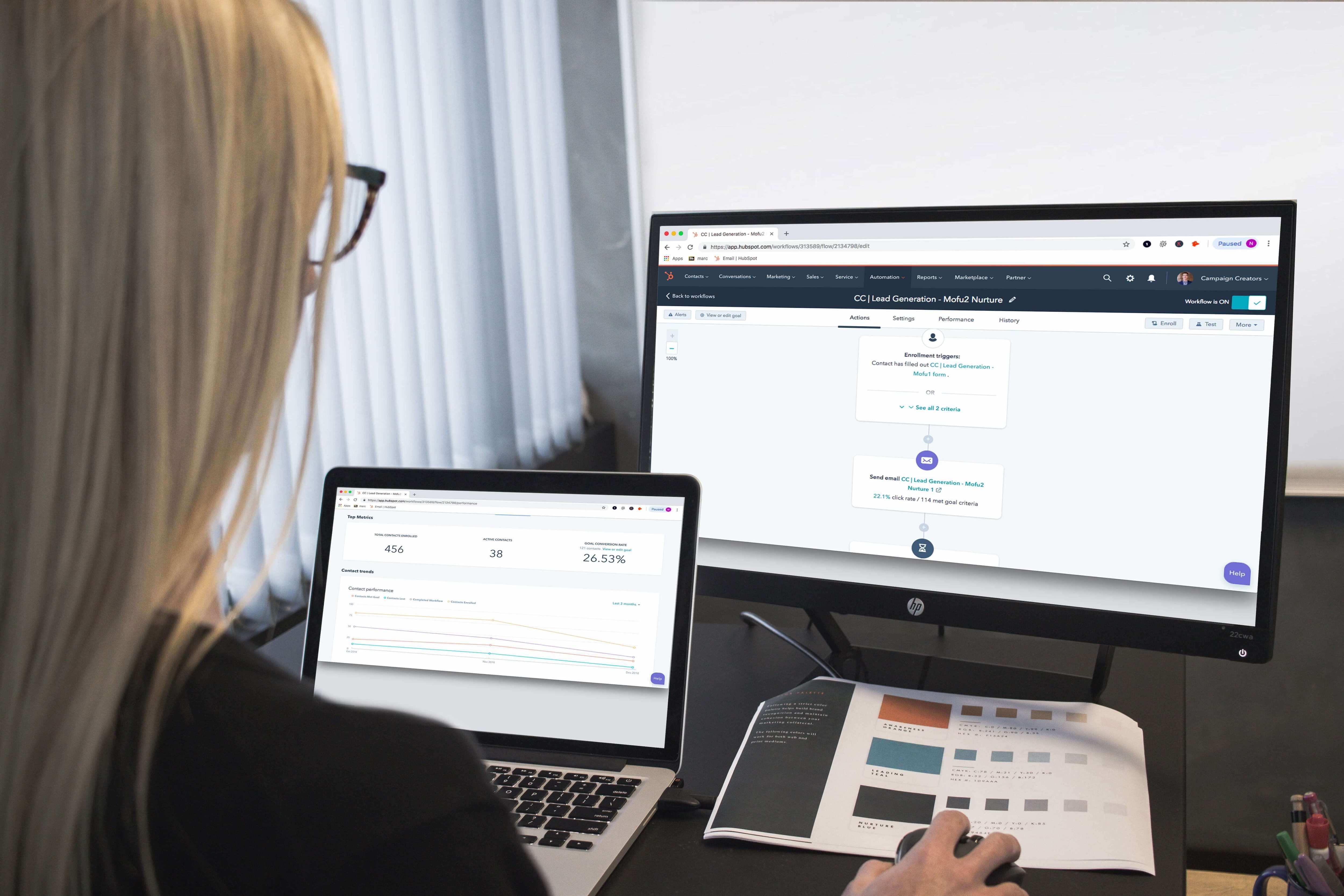
Now, how many emails should you include in each workflow? We suggest starting with a series of three emails that include the following:
- Email 1: A thank you for downloading the previous offer and a CTA to access that offer on your thank you landing page.
- Email 2: An introduction to the next offer and a CTA leading them to the next landing page in your series.
- Email 3: A promotion of the next offer and a CTA leading them to the next landing page in your series.
You may find over time that more (or less) emails are needed to get your leads to convert. That’s why it’s important to analyze and optimize your campaign overtime, not just set it and forget it—a topic we will cover more deeply in Lesson 9.
Workflows can also help bridge the gap between marketing and sales. For example, an email alerting a sales person could be triggered anytime a lead crosses the threshold turning them from a marketing qualified lead to a sales qualified lead. You could also use workflows to update contact information (such as a stage in the sales funnel) based on actions they take with your company on and offline.
Nurture Content
Nurture content in B2B primarily comes in the form of premium educational content that helps your buyer evaluate the different approaches or methods available to pursue their goal or solve their challenge. This point in the journey also marks a point of extended engagement where you are nurturing a lead, building a relationship, and establishing trust between the potential buyer and your brand.
Because the buyer’s journey tends to be longer and more complicated in B2B, several pieces of content are often required to successfully move them through the consideration and decision-making stages.
Examples of B2B nurture content includes:
- Case Studies
- Whitepapers
- Comparison Guides
Post-purchase Nurturing Content
Once a lead becomes a customer, your job as a marketer doesn’t end. In fact, you should be heavily invested in retaining their loyalty. Why? It is 5 times more expensive to acquire a new customer than it is to retain a current one. Furthermore, a happy customer can turn into an evangelist for your company—providing word of mouth marketing and referrals, which are incredibly powerful in B2B marketing.
Content focused on delighting the customer should:
- Help them get maximum value from your products or services. For example, provide use cases describing how clients are leveraging your product or service, share interesting case studies that demonstrate functionality, or hold client-only webinars that train them in using various features.
- Provide them useful information related to their industry and your product or service. For example, send a client newsletter once or twice a month with a collection of articles you have curated, and provide a brief summary with a link to read the full article.
- Build trust and deepen relationships between the customer and your company. For example, invite them to an exclusive event you are hosting. This lets them know you think of them as part of a bigger family, even if they don’t attend.
Reporting and Analytics
Analytics serve the crucial purpose of exposing the “leaky” parts of your funnel—places in which leads are failing to convert at expected levels. Because each B2B funnel set up is so customized, it is best to determine individual benchmarks to compare to rather than apply generic industry standards.
To fully understand the effectiveness of your B2B lead nurturing campaign, it’s incredibly important to have closed-loop reporting set up. This will likely involve working with your sales team and ensuring your marketing automation system and CRM are sharing data.
.svg)
The best metrics to focus on are those that are conversion-focused including:
- Landing page submission rates
- Email open and click-through rates
- Engagement with nurturing content (read/watch time and percentage)
- Workflow goal completion rates
- MQL to SQL rate
- Funnel completion rate and length
- Sales cycle length
- Cost per customer acquisition
Reporting on these analytics enable you to better understand which aspects of your B2B lead nurturing campaign are performing up to standards and which are candidates for optimization.
Optimization
With longer sales cycles, B2B lead nurturing campaigns often take a while to collect enough data to gain insights into many optimization opportunities; and the smaller databases often lack sufficient data for more complicated testing, like multivariate testing. However, it is fully possible to begin with more simple testing.
A/B testing is perfect for this type of campaign. Landing pages, email subject lines, and offer types can all be tailored to maximum effectiveness—provided you have the patience necessary to gather enough data to determine whether, and which, changes are making an impact.
We will dive much more deeply into testing and optimizing your lead nurturing campaign in Lesson 9.
Operator
Your B2B lead nurturing campaign operator should be heavy on upfront strategy, especially content strategy. They also need to possess some technical capabilities to set up the automated elements of the campaign, and analytical skills to monitor progress and effectiveness over the longer sales cycle. Can’t find one person who can do it all? That’s okay, these tasks can be delegated to multiple people who hold the necessary skill sets.
Automation Tools
A B2B lead nurturing campaign will not get off the ground without marketing automation. While email marketing may be what comes to mind when you consider “automation,” a B2B lead nurturing campaign will require more than just email automation. What do we mean by this?
A B2B lead nurturing campaign also requires programs to organize and segment leads, track contact behavior, create and optimize landing pages and forms, personalize content, provide analytics and more. And you want it all to integrate fluidly together to remove operational inefficiencies.
So honestly, you’re best bet is to invest in a comprehensive marketing automation platform that can handle all of these tasks in one place. Your primary options are:
- HubSpot
- Pardot
- Salesforce Marketing Cloud
- Marketo
Each marketing automation system has its pros and cons, but information is readily available to review for comparison by visiting websites like G2Crowd. We also cover many of these platforms, and how to choose the right one for you in Lesson 3.
How to Create a B2B Lead Nurturing Campaign in 4 Steps
Covered in the last lesson were several steps you should take when creating a lead nurturing campaign (in general). Now, we’ll cover the steps needed when creating a B2B lead nurturing campaign.
The 4 Steps to Creating a B2B Lead Nurturing Campaign:
- Define the goal of your lead nurturing campaign.
- Determine your target audience.
- Create content for each stage of the buyer’s journey.
- Tie it all together with automation.
Step 1: How to Define a Goal for Your B2B Lead Nurturing Campaign
Defining the goal of your B2B lead nurturing campaign gives you direction. Without a start, there is no finish. Your goal should be complementary to that of your prospective buyer, effectively benefiting you both. Knowing your goal beforehand also ensures your content targets the right audience’s problems with the right solutions.
One way to approach goal setting is to think about it from the top down - what persona, market segment or type of buyer am I trying to attract? In this case, your goal could be:
- Solve for the pain points of a particular persona or set of personas.
- Attain more customers from a specific industry or segment.
- Gain more customers who fit your ideal client profile.
- Increase purchases from current customers.
Another way to set your goal is from the bottom up - what product or service would you like to push right now? In this case your goals could be:
- Increase purchases for a particular product or service.
- Increase subscription sign ups.
- Increase registrations for an event.
- Increase license/contract renewals.
Or it could be that you are trying to improve your sales process by speeding it up or making it more efficient. In this case your goals could be:
- Decrease the time it takes a new lead to close as a customer (i.e., time to customer conversion)
- Decrease the number of manual touch points needed to close a sale.
- Decrease the cost per customer acquisition.

What are good B2B lead nurturing campaign goals?
In order for your goal to be “good” you need to take your general goal and make it S.M.A.R.T., as we covered in Lesson 6. For example, if your general goal was to sell more CRM software licenses, then your S.M.A.R.T. goal could be:
Sell 450 CRM licenses in Q4 by implementing a lead nurturing campaign.
Now you may also have some leading indicators or sub-goals for your primary goal. For example, if your goal is to sell 450 CRM licenses in Q4, then some subgoals might be:
- Increase click-through rates on lead nurturing emails by 10%.
- Increase MoFu landing page submission rates by 10%.
- Increase BoFu workflow completion rates by 1%.
- Increase customer satisfaction with the sales process by 1 point (10 pt. scale).
Step 2: Determine Your B2B Target Audience
In B2B, your target audience for your campaign will be determined by two things:
- Your buyer persona
- Your ideal client profile
If your goal was set from the top down (i.e., focused on attracting a particular customer) then you may already know at least one of these. If your goal was created from the bottom up, then you need to work backwards to determine which of your buyer persona’s this particular product or service solves for. If you have not already created buyer personas or an ideal client profile for your company, you must do this before moving forward.
B2B Buyer Personas
As a reminder, buyer personas are a semi-fictional representation of your ideal customer, based on market research and real data about your existing customers. When creating a B2B buyer persona you want to think about your persona in the context of work. So when thinking about their goals, ask yourself, “what are they trying to accomplish at work?”
In addition to items covered in Lesson 6, in the case of the B2B buyer persona, you also want to include:
- Job Responsibilities - What are they responsible for at work?
- Performance Measurement - How is their job performance measured? (e.g., revenue generated, team productivity, products delivered)
- Challenges - What are their biggest internal and external challenges at work?
- Vendor Communication - How do they prefer to communicate and interact with vendors? (e.g. email, phone, SMS, face-to-face, web chat)
In some marketing automation systems, such as HubSpot, you can even use buyer personas to base segmented contact lists on, to better target audiences with nurturing workflows.
Ideal Client Profiles
Ideal client profiles on the other hand are outlines of the ideal type of company you want to work with. Some very high-level items you can use to define this profile are:
- Industry
- Demographics
- Location
- Revenue
Think about your ideal client profile as the type of company you want to attract and your buyer persona as the person who works at that company—because we communicate with people, not companies.
Now to create your target audience you put the two together. For example, you may be targeting your persona, Marketing Mary, but you particularly want to attract Marketing Mary’s who work at companies that do at least 5 million in revenue and have at least one person dedicated solely to marketing—that is the target of your campaign!
Step 3: Create Content for Each Stage of Your B2B Target’s Buyer’s Journey
Mapping out your campaign content involves determining what educational information your buyer needs at each step of their buyer’s journey and determining the best (most conversion-oriented) channels to communicate and promote that content offer.
To map out your target’s buyer’s journey, you’ll first need to understand what information your audience needs at each stage of the buyer’s journey.
Remember, the three stages of a buyer’s journey are:
- The Awareness Stage
- The Consideration Stage
- The Decision Stage
Awareness Stage Content
The awareness stage is when your persona first senses they are experiencing a problem, or perhaps they are still even unaware of the problem they face. The goal at the end of engaging with your content is for your buyer to have identified their challenge or goal and decided to take action on it. Refer to Lesson 6 for an outline of the questions you need to answer with your awareness stage content.
If you are able to provide these answers to your potential buyers, you are ready to create content! Since this is the first time you are reaching out to these prospects, it’s important to create a visually appealing piece of content that not only looks professional, but gives value.
Awareness stage B2B lead nurturing content can include:

- E-books/Guides to offer leads an educational guide to follow while also positioning your brand favorably and as a trusted source of information.
- Workbooks to allow your leads to develop their own custom results based on your methodologies.
- Checklists to show your leads the steps needed to complete a process. A list can help leads learn the tasks needed to complete a project, determine what stage they are at in a process, or aid in accountability.
Consideration Stage Content
In the consideration stage, or middle of the funnel, your B2B buyer has identified the problem they have or goal they want to pursue, and that this is a priority. They are just now beginning to evaluate the possible solutions to their problem. So, this is the stage where you begin to make a case for why your solution in particular is the best fit.
Also, at this stage you want to help potential leads determine if they are not a good fit for your solution, which is important for customer retention in the long run. Remember, you are only interested in qualified leads!
It is important to note, that often before you can present a case for your solution, you need to help your lead evaluate the different categories of solutions available to them, not just the category you fall into. Likewise, several pieces of content may be required at this stage, especially for longer sales cycles or more complicated products/services. Once again, refer to Lesson 6 for an outline of the questions you need to answer to understand the Consideration stage for your buyer.
Once you understand the Consideration stage for your buyer you need to create a piece of content that includes the answers to these questions. The goal at the end of engaging with this content is for buyer’s to have selected the category of solution that is right for them and added you to the list of possible providers.
Consideration stage B2B lead nurturing content include:
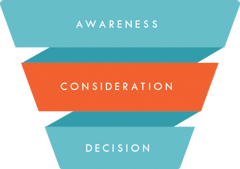
- Comparison Guides to help leads evaluate various solution categories and/or providers side by side.
- Whitepapers to offer in-depth, problem-solving guides to a lead.
- Webinars to engage and educate leads in a live manner on solution-based information regarding their problem.
Decision Stage Content
In the decision stage, or bottom of the funnel, your B2B buyer has decided on the category of solutions that is right for them and may even have a short list of providers. Now, they need a last deserving nudge in the right direction toward choosing you. In other words, you really need to differentiate yourself from the competitors in your category.
Often times in the decision stage, you will see the introduction of additional decision makers, also known as a sales persona. Up to this point you may have been marketing to a research persona, who may still have some influence in the decision to buy, but now you need to also address your sales persona’s pain points and common objections.
Once you understand the decision stage for your buyer (refer to Lesson 6), you have to determine the best offer to answer their questions and assure the “who” they buy their solution from is YOU.
Decision stage lead nurturing offers can include:
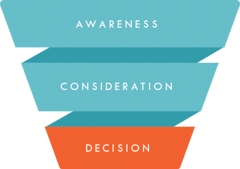
- Product/Service Demos to position your brand to your target audience.
- Free Trials to educate leads freely and empower them to learn autonomously.
- Free Consultations to give your lead a feel for the value you can provide.
- Pricing Quotes to help your buyer determine what is needed to move forward with purchasing.
Step 4: Tie Your Campaign Together with B2B Marketing Automation Software
Once you have created offers to match each stage of the buyer’s journey, you need to link these pieces together to create a funnel for your leads to travel down.
To do this you need to:
- Upload your premium content to your Content Management System.
- Create an organizational structure for your campaign assets in your marketing automation system.
- Build a landing page to host each offer.
- Build a thank you page to deliver each offer.
- Create lead nurturing emails to guide leads to the next stage.
- Create workflows to automate the sending of these emails.
So, your final campaign will look something like this:
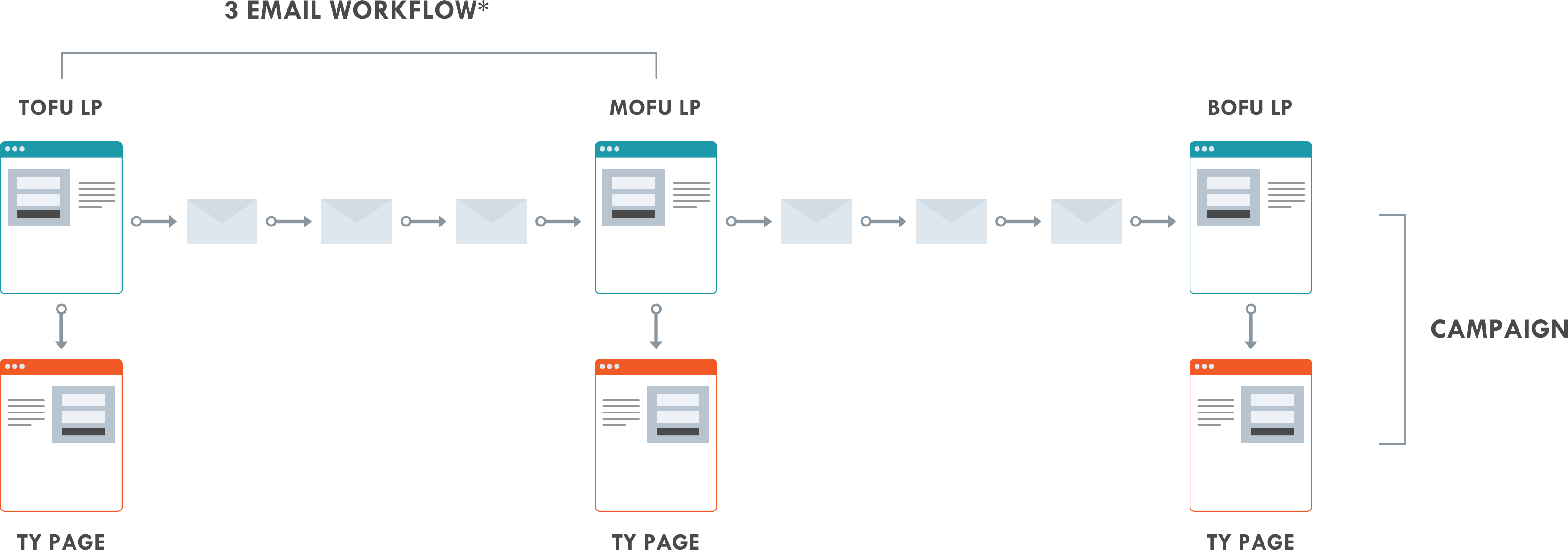
Generate Awareness for Your B2B Lead Nurturing Campaign
Now that you have created your campaign, you need to generate awareness for it. Why? Well, if no one enters the top of your campaign funnel, no one will ever reach the bottom. If we look at effects of generating awareness in a linear way, we see that it brings more visitors to your website whom can convert into leads, enter your campaign, and, down the line, turn into customers.
So, what does it mean to generate awareness for your B2B lead nurturing campaign? It means to attract the community your target audience is a part of. It means casting a large net in efforts to capture leads.
To generate awareness for your B2B audience, consider several awareness stage marketing tactics:
- Use your lead magnet as the offer in a Paid Ad.
- Offer your lead magnet to prospects on LinkedIn who match your persona and fit your ideal client profile.
- Include links to your lead magnet in relevant blogs or in pop-ups on relevant pages of your website.
- Create videos on LinkedIn or YouTube that provide inherent value, but also include a call to action to access your lead magnet.
- Add a hyperlink to the lead magnet in your marketing and sales team member’s email signature.
- Share your lead magnet on your company and employee’s social media accounts.
- Send a blast email to your database promoting your lead magnet.
- Print postcards promoting your lead magnet to pass out at events or mail to prospects.
The list goes on, but the most important thing is to continually feed the top of your funnel so all of your hard work crafting your campaign does not go to waste.
How to Handoff a Nurtured Lead from Marketing to Sales
Speaking of your hard work going to waste, you also want to make sure that the fruits of your labor are capitalized on by your sales team.
Unfortunately, due to the extended buyer’s journey your lead might face in B2B, contact records and data often go missing in the transfer to sales, and that can create a negative impact on the buyer when being handed-off from marketing to sales.
That’s why constant data sharing and alignment between sales and marketing teams is key. Doing so helps eliminate any friction that your lead might experience, which results in a happier, more delighted buyer.
This goes by the term: Smarketing, which is the alignment of sales and marketing.
Effectually, sales and marketing share common goals. Most importantly, they share an end goal of getting the successful conversion. In order to do so, they both utilize tools, such as creating buyer personas as well as using an integrated approach for nurturing a lead into a conversion.
To align sales and marketing, it’s about leveraging contact data. That means looking at a lead’s touchpoints with your brand during each stage of their buyer’s journey and your sales process. One way to ensure this is by integrating website analytics and a customer relationship management (CRM) software. The integration of these two types of software allows sharing of information between one and the other, which allows for sales and marketing teams to close the loop by providing a great customer experience.
Another way to close the gap between marketing and sales teams is by creating a workflow that will alert sales when a bottom of the funnel form is filled out, or when a lead hits a threshold lead score. This message can provide your sales person with the key information needed to make personalized and informed outreach quickly.
Additionally, if your company is larger in size and includes multiple sales teams, you can set up workflows that route leads to specific people, based on region, industry, or any other demographic information. Alerts for either the aforementioned or latter mentioned can be set up for over email, text or desktop notification.
Feel like you have a better understanding of lead nurturing campaigns for B2B companies? Take your learning to the next level by applying your knowledge in the Lesson 7 Exercise below.
Lesson 7 Exercise
Brainstorm Your Lead Nurturing Offers
Refer back to the exercise you completed in Lesson 2—Map Out Your Buyer’s Journey. Use your map to brainstorm a piece of content or offer that you could provide your persona at each stage of their buyer’s journey.
1. Awareness StageBrainstorm an offer that helps your persona identify their paint point or goal. This can be in the form of a checklist, quiz, guide, workbook, or assessment.
2. Consideration StageThink of an offer that could help your persona choose a solution category. This can be in the form of a whitepaper, eBook, webinar, or video.
3. Decision StageBrainstorm an offer that could help your persona decide to buy from you. This can be in the form of a case study, success story, consultation, coupon, or demo.
In Lesson 8 of the Lead Nurturing Master Course, we’ll be covering in detail how to craft lead nurturing campaigns for B2C and ECommerce. If you aren’t interested in B2C campaigns, skip ahead to Lesson 9 to learn how to optimize your lead nurturing campaign.

